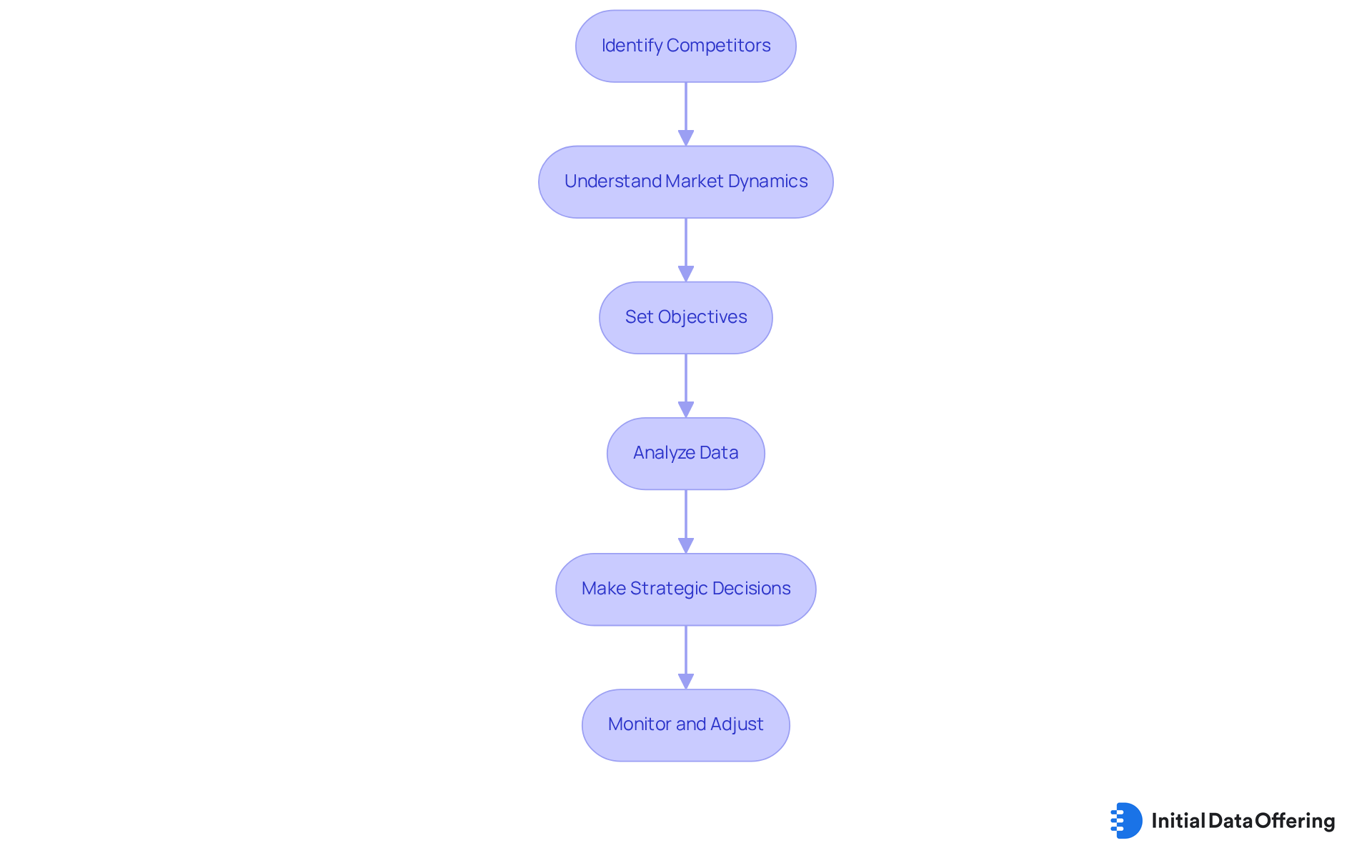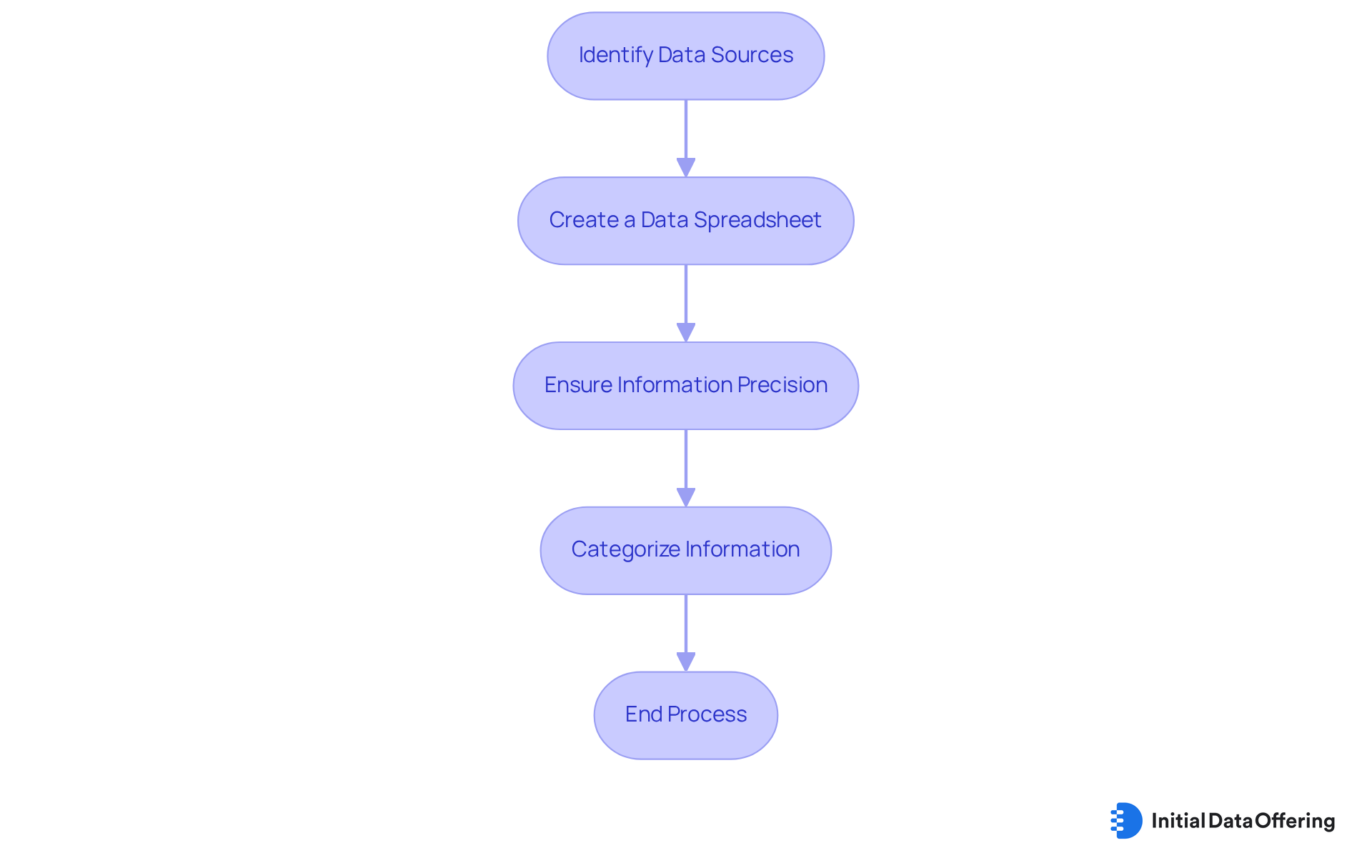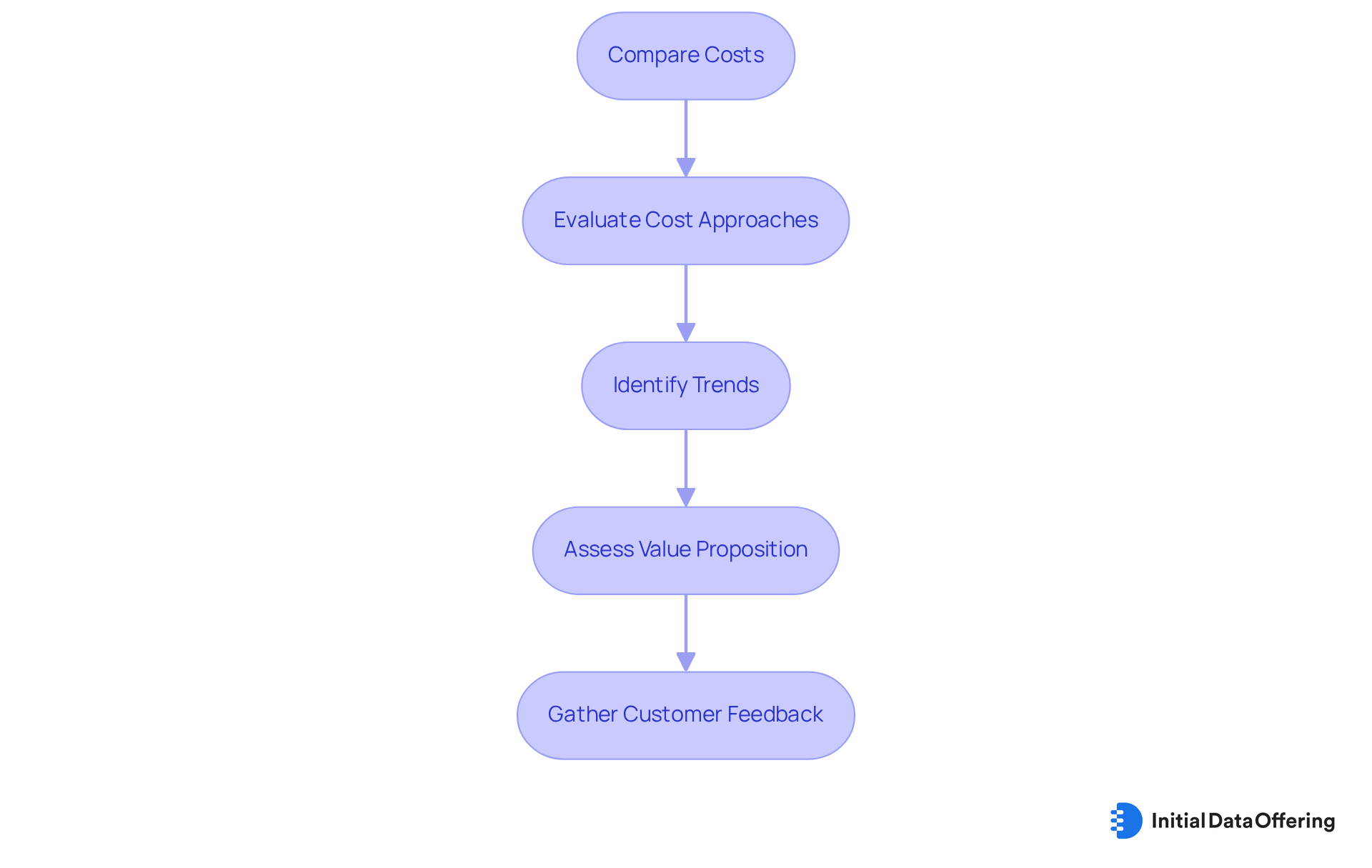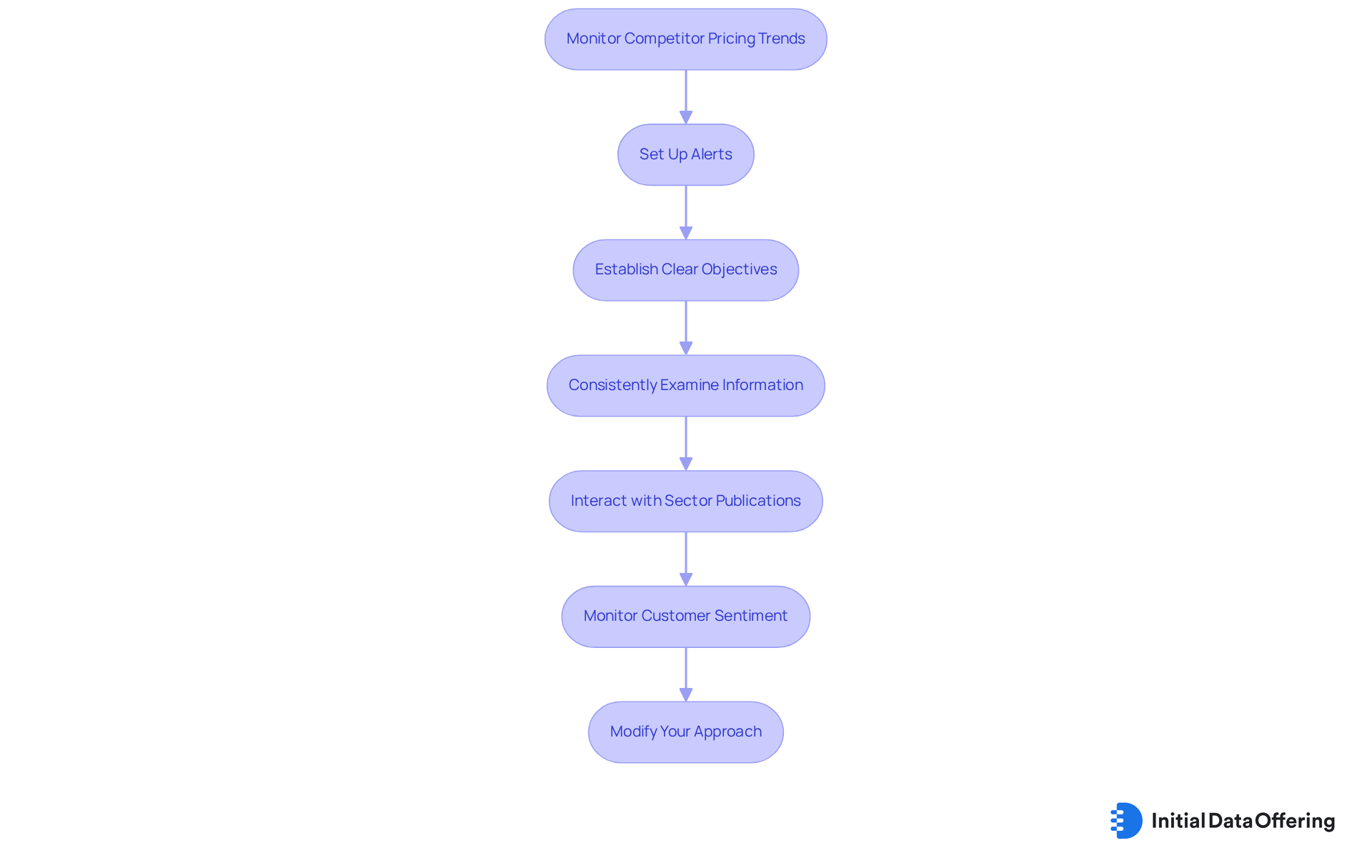4 Steps to Effectively Use Competitor Pricing Data

4 Steps to Effectively Use Competitor Pricing Data
Overview
The article outlines four essential steps for effectively utilizing competitor pricing data:
- Identifying competitors
- Collecting and organizing pricing information
- Analyzing and interpreting the data
- Monitoring pricing trends
Each step is crucial for businesses aiming to enhance their market strategy. By identifying competitors, companies can better understand their market landscape. Collecting and organizing pricing information allows for a systematic approach to data management. Analyzing and interpreting this data leads to informed decision-making, which is vital for strategic planning. Finally, monitoring pricing trends ensures that a company remains competitive and responsive to market changes.
These steps are supported by examples and strategies that demonstrate how structured data analysis can lead to improved market positioning. Ultimately, this process enhances a company's profitability and competitive edge.
How can these steps be integrated into your pricing strategy to maximize results?
Introduction
In a market where pricing strategies can significantly impact a business's success, understanding the nuances of competitor pricing data is essential. This guide explores the systematic approach to competitive pricing analysis, revealing how organizations can leverage insights to enhance their market positioning and profitability. As companies navigate the complexities of pricing dynamics, they must consider a crucial question: how can they effectively harness this data to not only remain competitive but also drive sustainable growth?
Understand Competitive Pricing Analysis
Competitive cost analysis is a critical process that involves evaluating competitor pricing data for similar products or services offered by rivals. This analysis not only assists companies in comprehending their costs in relation to the market but also utilizes competitor pricing data to guide strategic choices that can improve market positioning and profitability. For instance, a national grocery retailer achieved a 4% increase in sales within six months after improving their cost strategy, demonstrating the tangible benefits of effective competitive cost analysis.
To effectively conduct competitive pricing analysis in 2025, consider the following steps:
- Identify Competitors: Begin by pinpointing your direct competitors. This includes businesses that offer similar products or services, allowing for a focused comparison.
- Understand Market Dynamics: Gain insights into the factors that affect costs within your industry. Key components encompass demand variations, supply chain factors, and changing consumer preferences, all of which can significantly affect cost strategies.
- Set Objectives: Clearly define your goals for the cost strategy. Whether your aim is to capture market share, maximize profits, or enhance brand positioning, having specific objectives will guide your analysis and decision-making process.
As Natasha Gomes highlights, genuine market strategy extends beyond computing margins; it’s based in customer psychology. By creating a strong structure for competitive cost analysis that incorporates competitor pricing data, companies can utilize data-driven insights to make informed decisions that align with their strategic objectives. Furthermore, using tools such as Visualping for real-time tracking of rivals' cost adjustments can further improve the efficiency of your analysis. By linking information suppliers with prospective purchasers, IDO enables knowledge transfer that can foster innovation and strategic planning across multiple sectors.

Collect and Organize Competitor Pricing Data
To effectively collect and organize competitor pricing data, it is essential to follow these steps:
-
Identify Data Sources: Utilize a variety of sources for pricing information, such as competitor websites, online marketplaces, and industry reports. Web scraping tools like Visualping or PromptCloud can streamline the information collection process, enabling automated extraction from multiple platforms.
-
Create a Data Spreadsheet: Structure the collected information in a well-organized spreadsheet. Essential columns should include competitor names, product or service descriptions, prices, and relevant details like discounts or promotional offers. This structured approach not only facilitates easy reference but also enhances analysis capabilities.
-
Ensure Information Precision: Regularly verify the accuracy of your collected data. Given the dynamic nature of pricing, maintaining up-to-date information is crucial for reliable analysis. Conducting regular inspections can help reduce discrepancies and ensure data integrity. Additionally, consider cleaning techniques such as removing duplicates and standardizing formats before storing the cleaned information.
-
Categorize Information: Group the information by product categories or service types to simplify future analysis. This categorization enhances clarity and aids in identifying trends and patterns across different segments.
By systematically gathering and organizing competitor pricing data, you create a solid foundation for insightful analysis and informed decision-making. As industry specialists note, 'Precise and structured information is essential for grasping market dynamics and making strategic choices.

Analyze and Interpret Pricing Data
Once you have organized your competitor pricing data, it is essential to analyze and interpret it effectively to gain a competitive edge:
-
Compare Costs: Start by identifying trends in the cost data. Which rivals have higher or lower rates? Understanding the fundamental causes for these variations, such as positioning within the industry or product characteristics, is crucial. This analysis can reveal insights from competitor pricing data that directly impact your pricing strategies.
-
Evaluate Cost Approaches: Next, assess the cost strategies employed by competitors. Are they using penetration strategies to gain market share, skimming to maximize profits on new products, or value-based approaches that align with customer perceptions? Comprehending competitor pricing data can help inform your own cost decisions. Notably, more than one-third (37%) of manufacturers and distributors currently utilize AI for price management, indicating a growing trend in leveraging technology for cost strategies.
-
Identify Trends: It is also important to monitor cost trends over time to determine whether prices are rising or falling. Such trends can signal market shifts or changes in consumer demand, providing critical insights for strategic adjustments. In this context, dynamic pricing—enabling real-time price changes based on demand and rival rates—becomes especially significant.
-
Assess Value Proposition: Lastly, evaluate how your product or service compares against competitors in terms of value. If your costs are higher, ensure you can justify this with superior quality, unique features, or exceptional service. Remember, a 1% enhancement in costs can lead to an 8.7% rise in operating profit, underscoring the financial impact of effective cost strategies.
Furthermore, gathering customer feedback is essential for aligning your cost strategies with customer expectations. Be mindful of obstacles such as information accuracy and availability, which can complicate the analysis of competitor pricing data. Addressing these issues is crucial as you analyze your financial information.
By thoroughly analyzing and interpreting cost data, you can develop strategies that not only enhance your competitive edge but also align with market dynamics and consumer expectations.

Monitor Competitor Pricing Trends
To effectively monitor competitor pricing trends, implement the following strategies:
-
Set Up Alerts: Utilize tools such as Google Alerts or specialized price tracking software to receive immediate notifications when rivals adjust their prices or introduce new products. This proactive approach allows businesses to stay informed about market changes in real-time, ensuring they can respond swiftly to competitive actions.
-
Establish Clear Objectives: Before choosing a price monitoring tool, it’s essential to set clear objectives that align with your business goals. This foundational step ensures that your monitoring efforts are focused and effective, ultimately leading to better strategic decisions.
-
Consistently Examine Information: Create a schedule for assessing rival cost information, preferably on a weekly or monthly basis. This practice aids in recognizing important changes and new trends, allowing for timely modifications to your cost strategy. Statistics indicate that a substantial portion of companies that consistently analyze competitor pricing data are more capable of reacting to industry changes, enhancing their market position.
-
Interact with Sector Publications: Subscribe to industry reports and analysis publications that provide insights into cost trends and industry dynamics. These resources can offer valuable context and assist you in comprehending wider economic trends, enriching your pricing strategies.
-
Monitor Customer Sentiment: Keep an eye on customer feedback and sentiment through keywords. This can improve your comprehension of economic forces and guide your cost strategies, ensuring they resonate with market demands.
-
Modify Your Approach: Be prepared to adjust your cost strategy according to the insights acquired from observing rival trends. Flexibility is crucial in a competitive landscape, as it allows businesses to respond effectively to market shifts. Delayed reactions to price changes can lead to lost sales and damage to brand perception, highlighting the importance of agility in pricing decisions.
Regularly monitoring competitor pricing data ensures that your pricing strategies remain relevant and competitive, ultimately driving better business outcomes. Are you ready to implement these strategies for enhanced market responsiveness?

Conclusion
Understanding and effectively utilizing competitor pricing data is essential for businesses aiming to enhance their market positioning and profitability. Engaging in a thorough competitive pricing analysis allows companies to make informed strategic decisions that align with customer expectations and market dynamics. This proactive approach not only enables businesses to identify trends and adjust their pricing strategies but also fosters a deeper understanding of their competitive landscape.
The article outlines four critical steps in leveraging competitor pricing data:
- Identifying competitors
- Collecting and organizing pricing information
- Analyzing and interpreting the data
- Monitoring ongoing pricing trends
Each step is designed to build upon the previous one, ensuring that businesses can develop a comprehensive understanding of their market position. Tools and techniques, such as data spreadsheets and real-time tracking software, play a pivotal role in streamlining this process and enhancing data accuracy.
In conclusion, the significance of competitor pricing analysis cannot be overstated. As markets continue to evolve, businesses must remain agile and responsive to changes within their industry. By implementing the strategies discussed, companies can not only improve their pricing strategies but also foster innovation and maintain a competitive edge. Embracing this data-driven approach is vital for long-term success and sustainability in a rapidly changing marketplace.
Frequently Asked Questions
What is competitive pricing analysis?
Competitive pricing analysis is the process of evaluating competitor pricing data for similar products or services. It helps companies understand their costs in relation to the market and guides strategic choices to improve market positioning and profitability.
Why is competitive pricing analysis important?
It allows companies to comprehend their costs compared to competitors, which can lead to improved market positioning and profitability. An example includes a national grocery retailer that saw a 4% increase in sales after enhancing their cost strategy based on competitive pricing analysis.
What are the steps to conduct competitive pricing analysis in 2025?
The steps include: 1. Identify Competitors: Pinpoint direct competitors offering similar products or services. 2. Understand Market Dynamics: Gain insights into factors affecting costs, such as demand variations, supply chain factors, and consumer preferences. 3. Set Objectives: Define specific goals for the cost strategy, such as capturing market share or maximizing profits.
How does customer psychology relate to competitive pricing analysis?
Genuine market strategy is based on customer psychology, meaning that understanding customer behavior and preferences is crucial for creating effective pricing strategies that align with market demands.
What tools can enhance competitive pricing analysis?
Tools like Visualping can be used for real-time tracking of competitors' cost adjustments, improving the efficiency of the analysis process.
How does IDO facilitate knowledge transfer in competitive pricing analysis?
IDO connects information suppliers with prospective purchasers, fostering innovation and strategic planning across multiple sectors by enabling the transfer of knowledge related to pricing and market dynamics.